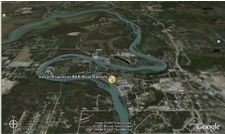The pink salmon (Oncorhynchus gorbuscha) is also known as the "humpback" or "humpy" because of its very pronounced, laterally flattened hump which develops on the backs of adult males before spawning. It is called the "bread and butter" fish in many Alaskan coastal fishing communities because of its importance to commercial fisheries and thus to local economies. Pink salmon also contribute substantially to the catch of sport anglers and subsistence users in Alaska. It is native to Pacific and arctic coastal waters from northern California to the Mackenzie River, Canada, and to the west from the Lena River in Siberia to Korea.
General description: The pink salmon is the smallest of the Pacific salmon found in North America with an average weight of about 3.5 to 4 pounds and average length of 20-25 inches. An adult fish returning to coastal waters is bright steely blue on top and silvery on the sides with many large black spots on the back and entire tail fin. Its scales are very small and the flesh is pink. As the fish approaches the spawning streams the bright appearance of the male is replaced by brown to black above with a white belly; females become olive green with dusky bars or patches above and a light-colored belly. By the time the male enters the spawning stream, it has developed the characteristic hump and hooked jaws. Juvenile pink salmon are entirely silvery, without the dark vertical bars, or parr marks, of the young of other salmon species.
Life history: Adult pink salmon enter Alaska spawning streams between late June and mid-October. Different races or runs with differing spawning times frequently occur in adjacent streams or even within the same stream. Most pink salmon spawn within a few miles of the coast and spawning within the intertidal zone or the mouth of streams is very common. Shallow riffles where flowing water breaks over coarse gravel or cobble-size rock and the downstream ends of pools are favored spawning areas. The female pink salmon carries 1,500 to 2,000 eggs depending on her size. She digs a nest, or redd, with her tail and releases the eggs into the nest. They are immediately fertilized by one or more males and then covered by further digging action of the female. The process is commonly repeated several times until all the female's eggs have been released. After spawning, both males and females soon die, usually within two weeks.
Sometime during early to mid-winter, eggs hatch. The alevins, or young fry, feed on the attached yolk sac material continuing to grow and develop. In late winter or spring, the fry swim up out of the gravel and migrate downstream into salt water. The emergence and outmigration of fry is heaviest during hours of darkness and usually lasts for several weeks before all the fry have emerged.
Following entry into salt water, the juvenile pink salmon move along the beaches in dense schools near the surface, feeding on plankton, larval fishes, and occasional insects. Predation is heavy on the very small, newly emerged fry, but growth is rapid. By fall, at an age of about 1 year, the juvenile pink salmon are 4 to 6 inches long and are moving into the ocean feeding grounds in the Gulf of Alaska and Aleutian Islands areas. High seas tag-and-recapture experiments have revealed that pink salmon originating from specific coastal areas have characteristic distributions at sea which are overlapping, nonrandom, and nearly identical from year to year. The ranges of Alaska pink salmon at sea and pink salmon from Asia, British Columbia, and Washington overlap each other.
Pink salmon mature in two years which means that odd-year and even-year populations are essentially unrelated. Frequently in a particular stream the other odd-year or even-year cycle will predominate, although in some streams both odd- and even-year pink salmon are about equally abundant. Occasionally cycle dominance will shift, and the previously weak cycle will become most abundant.
Commercial fishing: In the early years, fixed and floating fish traps were employed extensively to catch pink salmon; such traps were prohibited following statehood in 1959. Now most pink salmon are taken with purse seines and drift or set gillnets. Lesser numbers are taken with troll gear or beach seines. The average annual Alaska harvest since 1959 is 45.1 million pink salmon. The ten-year average harvest (1983-1992) is 77.4 million pink salmon. In 1991 the Alaska harvest represented about 96 percent of the total North American harvest.
Pink salmon fisheries are important in all coastal regions of Alaska south of Kotzebue Sound. Commercial canning and salting of pink salmon began in the late 1800s and expanded steadily until about 1920. Runs declined markedly during the 1940s and 1950s; however, intensive effort is being made to rebuild and enhance those runs through hatcheries, fish ladders, and improved fisheries management.






